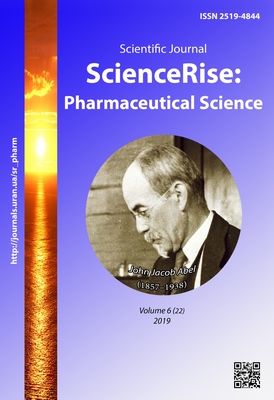Research on the development of dental gel technology with metronidazole benzoate and hyaluronic acid
DOI:
https://doi.org/10.15587/2519-4852.2019.189949Keywords:
technology, solubility, suspension, homogenization, gel, dentistryAbstract
Aim. Development of technology of dental gel with combined composition, establishment of optimal technological parameters for the introduction of active and auxiliary substances.
Methods. After production of experimental gel, we determined homogeneity for the samples with the method of SPhU 1.1, section 511. The particle size of the suspension was studied using a XY-B2TLED microscope under polarized light according to SPhU 2.9.37. The quantitative determination of metronidazole benzoate and the accompanying impurities A, B, C, miramistin, sodium hyaluronate was performed by liquid chromatography, according to SPhU section 2.2.29, section 2.2.46.
Results. According to the results of chemical and microscopic studies, the optimal method of introducing metronidazole benzoate into the gel base is the suspension method. To ensure the best distribution of metronidazole benzoate, a micronized substance was used and the technological parameters of pre-homogenization of metronidazole benzoate in propylene glycol at 20-25 °C were determined. Microphotographs of the gel samples showed that homogenization of metronidazole benzoate with propylene glycol at a speed of 3000 to 4000 rpm provides a homogeneous translucent gel of white colour. Selected methods of dissolution and technological parameters allow to obtain a stable gel without degradation products of active substances.
Conclusions. The optimal way of introducing into the gel base the combination of active substances: metronidazole benzoate, myramistine, hyaluronate sodium is substantiated. The rational technology of production of the combined dental gel is developed. Critical stages and parameters of technological process are defined, criteria of their acceptability are established
References
- Alimskii, A. V., Dmitrieva, L. A., Maksimovskii, Iu. M. et. al.; Dmitrieva L. A., Maksimovskii Iu. M. (Red.) (2009). Terapevticheskaia stomatologiia. Moscow: GEOTAR-Media, 908.
- Mazur, I. P., Peredrii, V. A., Dulko, S. V. (2010). Farmakolohichni zasoby dlia mistsevoho likuvannia tkanyn parodontu. Sovremennaia stomatolohyia, 5, 47–52.
- Sreenivasan, P. K., Gaffar, A. (2007). Antibacterials as anti-inflammatory agents: Dual action agents for oral health. Antonie van Leeuwenhoek, 93 (3), 227–239. doi: http://doi.org/10.1007/s10482-007-9197-8
- Pattanshetti, J. I., Tiwari, I., Singh, G., Tazyeen, F., Parihar, A. S., Khare, N. (2016). Local drug delivery modalities in treatment of periodontitis: a review. Journal of International Oral Health, 8 (2), 296–301.
- Ofner, C. M., Klech-Gelotte, C. M.; Swarbrick, J., Boylan, J. C. (Eds.) (2002). Gels and jellies. Encyclopedia of Pharmaceutical Tehnology. Vol. 2. New York; Basel: Marsel Dekker, 1327–1344.
- Shafiei, F.; Memarpour, M. (2012). Antibacterial activity in adhesive dentistry: a literature review. General dentistry, 60 (6), e346–356.
- Vynohradova, O. M. (2013). Vykorystannia suchasnykh antymikrobnykh i protyzapalnykh preparativ mistsevoi dii v likuvanni zapalnykh zakhvoriuvan parodontu. Zdobutky klinichnoi i eksperymentalnoi medytsyny, 2, 47–49.
- Derzhavna farmakopeia Ukrainy. Vol. 2 (2014). Kharkiv: Derzh. p-vo «Naukovo-ekspertnyi farmakopeinyi tsentr yakosti likarskykh zasobiv», 724.
- Ialkaev, A. G., Kataev, V. A., Kildiiarov, F. Kh. (2014). Lekarstvennye formy metronidazola s modificiruemym vysvobozhdeniem. Medicinskii vestnik Bashkortostana, 9 (6), 112–115.
- European Pharmacopoeia. EDQM (2016). Strasbourg: Council of Europe, 4016.
- Carbopol® Ultrez 10 Polymer, Technical Data Sheet (TDS-225) (2002). Lubrizol: Cleveland.
- Doslidzhennia z vyboru dopomizhnykh rechovyn u skladi kombinovanoho stomatolohichnoho heliu (2018). Suchasni dosiahnennia farmatsevtychnoi tekhnolohii i biotekhnolohii, 5, 272–275.
- Setkina, S. B., Khishova, O. M. (2014). Biofarmacevticheskie aspekty tekhnologii lekarstvennykh sredstv i puti modifikacii biodostupnosti. Vestnik VGMU, 4, 162–172.
- Rowe, R. C., Sheskey, P. J., Cook, W. G., Fenton, M. E. (Eds). (2012). Handbook of Pharmaceutical Excipients. London: Pharmaceutical Press, 1064.
Downloads
Published
How to Cite
Issue
Section
License
Copyright (c) 2019 Dmytro Orlenko, Volodymyr Yakovenko, Liliia Vyshnevska

This work is licensed under a Creative Commons Attribution 4.0 International License.
Our journal abides by the Creative Commons CC BY copyright rights and permissions for open access journals.








